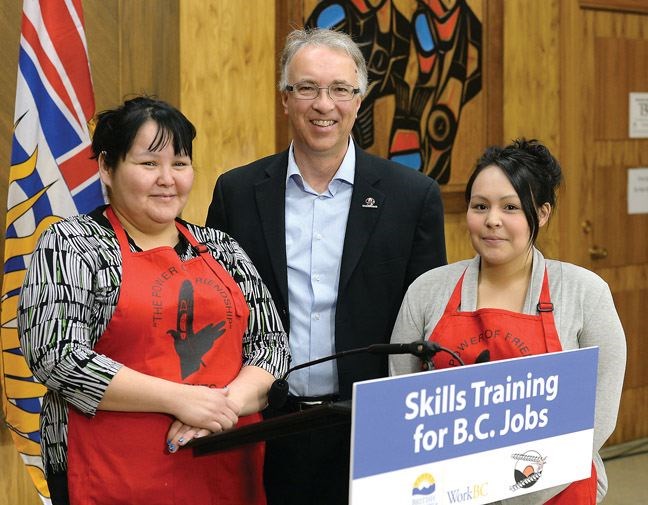John Rustad, the minister of aboriginal relations and reconciliation, continues to log in long hours and even more kilometres, working on building relationships and trust with the B.C. First Nations community, exactly what Premier Christy Clark instructed him to do when she appointed him in 2013.
There are still many points of impasse, but the provincial budget has been carved in new ways in the past number of years to pay First Nations for things like tracts of timber to be harvested for which the First Nation of that respective area would be primary shareholder in the venture. Likewise, mining and natural gas business has been arranged in the same way. A few treaties have been concluded in the past five years (the Maa-nulth and Tsawwassen are complete, with three more set to take effect shortly). Many more are at advanced stages in the negotiation process, while some First Nations are at the table with little motivation to go farther or are outright opponents of signing a treaty.
It makes Rustad, one of the busiest cabinet ministers in government.
"Oh, you noticed," said Premier Christy Clark during her recent exclusive interview with the Citizen. One of the topics she spent the most time discussing was the current state of aboriginal relations.
"John works with Treasury Board and we do have a First Nations committee of cabinet, a working group within cabinet, which I chair," said Clark. "The thing about First Nations issues is, on the First Nations side they think of things holistically. They don't want to talk about just forestry, they want to talk about social conditions, they want to talk about early childhood development. And from our side, too, we need to be thinking about these things broadly, so it's not just a forestry agreement. We are also thinking about how we can support the community, give people the tools they need to succeed, and that's really why we created the committee, so we are working across government, trying to break down the silos. It has worked a lot better. We have signed 400 agreements, most of them economic, since I became premier. We have seen some treaties, finally, produced."
Clark said she respects and understands the reasoning behind many First Nations wish to eschew the treaty process. Each aboriginal community has a different set of circumstances, and other sorts of agreements can be struck to cover the needs and wants of each one on their own terms. The ones that want it most and have worked the hardest to get to a full treaty should, she said, be the focus of the official treaty process while others can be addressed case by case, issue by issue.
"Treaties are still the gold standard for discussion," she said, but it takes three sides talking. It has been typically quite easy for the province and the First Nations of B.C. to find each other, but the third critical voice lawfully required for a treaty to be negotiated is the Government of Canada.
"And we now have a federal government that's finally coming back to the table," Clark said. "Over the years they have been very slow and reluctant, I think, to engage deeply, and this new federal government is showing every sign that they want to. Having them at the table will make all the difference, because a provincial government is not responsible for First Nations schools (for example). The federal government has a constitutional responsibility for that, and a lot of First Nations will tell you, until our schools are fixed, we're not interested in having any more conversations. So we need the federal government to step up and do their part."
If the treaty process is the gold standard for aboriginal relationships, then the Nisga'a Agreement is the gold standard for treaties. It was signed in 1999, exactly 100 years since the last such agreement in B.C. (that being Treaty 8 that sets out the relationship for the nations of the B.C. northeast, from McLeod Lake up into the Northwest Territories and east to parts of Saskatchewan). Attaining the Nisga'a Final Agreement was a modern treaty, and a template-setter.
"It is incredible what the Nisga'a have accomplished since their treaty came into force," said Clark. "And I would argue the achievement of their treaty is really what enabled that blossoming, not that they weren't always entrepreneurial, but it was really hard to get a foothold and their treaty has given them that."
There are pockets of aboriginal opposition to the economic activities that the provincial government is involved with. In the long past, such dialogue was seen with "us versus them" eyes in the public and in government. Those times have changed drastically, and Clark merely sees the opponents of economic development as voices expressing concerns that must be investigated validity and addressed honestly.
Failure to do so, on the part of any level of government or private enterprise, could easily result in a slammed door on any given project.
"I would differentiate First Nations concerns: people who have been there for millennia," Clark said. "First Nations concerns are in a little bit of a different category than the folks who travel around the province and say no to everything, and kind of crowd around."
With a federal government professing to be ready to change Ottawa's stance with First Nations, and with so many major industrial projects on the cusp of final investment decisions, this year is setting up to be eventful in the history of aboriginal communities and the larger provincial one.



